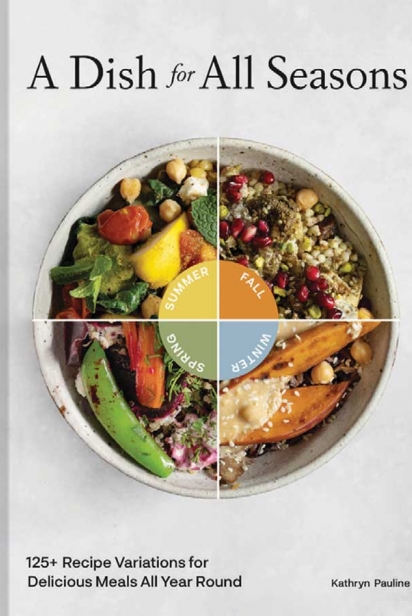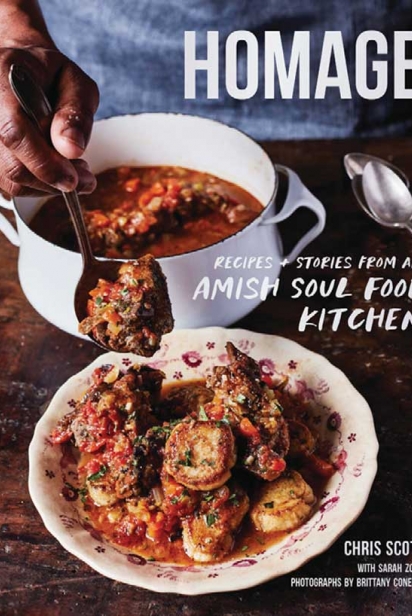Culinary Reads: Gifts that Keep on Giving
The Herbivorous Butcher
BY AUBRY AND KALE WALCH (Chronicle Books, 2022)
AUBRY AND KALE WALCH mince no words about why they do what they do. The siblings share their story in the introduction to The Herbivorous Butcher, a cookbook with more than 75 recipes for plant-based dishes from the Minneapolis vegan butcher shop of the same name.
A “modest reduction in the consumption of animal products” would be better for the earth, for animals and for one’s health, they write. “Together we can all change the world—one meal at a time.”
The cookbook details how a love of the flavor and texture of meat—including Spam, popular in their native Guam— led the two dedicated vegans to create meatless alternatives. Started as a popup and booth at the Minneapolis Farmers Market in 2014, The Herbivorous Butcher moved into a brick-and-mortar shop two years later, selling vegan versions of pork chops, ground beef, chicken cutlets and Chamarro chorizo, among others, plus plant-based deli meats and cheeses.
“Our experience says humans become vegan for their own health and the health of the planet and all of its creatures, not because meat and dairy taste bad,” writes Aubry Walch.
Though plant-based options are plentiful these days, they lacked “the depth of flavor, that savory umami,” writes Kale Walch, adding that many home cooks don’t know how to turn plant-based meat—theirs or other products—into inventive dishes or standout meals. In many cases, cooks can use the same application they would for a meat product, from porterhouse steak to Korean barbecue, fish sticks to dal, he says.
“Obviously a vegan butcher shop is an oxymoron,” he says. “We now have a loyal—some say cult-like—following and we ship all over the United States.”
“Through the magic of food science, you can make fool-your-friends meat bases and then manipulate everything about the savory doughs, from the basic flavor to the texture to the way it’s served. There are endless possibilities. Discovering that was so exciting to me, and I hope it will be for you too.”
Grist: A Practical Guide to Cooking Grains, Beans, Seeds, and Legumes: 140+ Recipes and 160+ Variations
BY ABRA BERENS (Chronicle Books, 2021)
PUBLISHED IN LATE 2021, this 448-page grain-and-bean-focused tome practically asks to be a gift for someone who loves getting a deeper understanding of their ingredients, especially someone whose New Year’s resolution includes cooking healthier (and in this case likely heartier) meals, or follows a gluten-free diet.
Author Abra Berens, who also wrote the popular Ruffage: A Practical Guide to Vegetables, is executive chef at the experiential dinners hosted at Granor Farm in southwest Michigan. Ingredients that might otherwise get a too-earthy shake become extra approachable and inviting, thanks to Berens.
Along with featuring 28 types of grains, legumes and seeds, Berens recommends pantry staples, provides plans for a week’s worth of barley or lentil dishes, and intersperses farmer interviews throughout. Pages come to life with illustrations that explain processes such as milling or the anatomy of grain, and tantalizing photos by Detroit-based photographer EE Berger.
Each chapter introduces a different grain or legume, from its botanical name and origin to protein content and preparation methods, before diving into recipes. Berens provides variations—and encouragement—to help home cooks find their own outcome.
“I was once adamant that chickpeas be cooked from dry. I wanted the long, slow process of soaking, simmering, and skimming. I wanted it to take all night. Something more than a fleeting fling. Something more than a thirty-minute meal,” she writes, calling the chickpea “the perfect kitchen partner.”
Then Berens embraces the practicality that this book imbues, and how it’s OK to open a can of chickpeas if it means having dinner ready a short time later.
“I once thought our passion was only proved with hours and hours of fawning,” she says. “Our relationship has evolved.”
Chances are Berens’ Grist will help your own—or a loved one’s— relationship with grains and legumes evolve too.
A Dish for All Seasons
BY KATHRYN PAULINE (Chronicle Books, 2022)
WITH NEW YEAR’S right around the corner, A Dish for All Seasons seems like the perfect gift for someone resolving to try new recipes year round.
This cookbook provides 25 base recipes that vary with the season, the technique and whatever you might dare to add to the more than 125 variations Pauline provides.
A Saveur Award winner for her blog Cardamom and Tea, Pauline lays out how her experiences at farmers markets have taught her what to expect and when, and how she “learned the real secret to on-the-fly seasonal shopping: Build a repertoire of easily adaptable recipes to use with whatever produce you find.”
“You’ll learn to think on your feet, use what you have, and find inspiration in the present moment,” she writes in her introduction. “Being a good cook is all about knowing how to adapt your plan to make use of what’s in season, because in-season produce tends to be the best quality, the least expensive and the easiest to find.”
Seasonal color-coding guides readers through the cookbook’s 287 pages, along with tempting photos. For frittatas, Pauline suggests a summer iteration with zucchini and tomato, a Persian date version for fall, a Spanish tortilla frittata in wintertime and one with asparagus and goat cheese in the spring. For other breakfasts, expect seasonal shakshukas and season-appropriate toppings on breakfast carbs. Salad variations include a summery watermelon fattoush, autumnal garlicky kale, citrus salmon and asparagus wedge, plus options for panzanellas, bean salads and slaws.
She continues with sides to mains— including inventive soups, grain bowls, fish tacos and even sandwiches, whole chickens and pasta with meatballs— ending with sweets like fruit galettes featuring pear saffron cinnamon or rhubarb pistachio frangipane, among others.
“There is more than one right way to use this cookbook,” she writes, pointing to recipes plenty adaptable for those who prefer structure, but with the freedom for more free-spirited cooks to flourish. Pauline gives permission to find your own inspiration. She’s there to help build the foundation, and then encourages you to either follow along or to take off as the architect of your meal.
The Art of Whisky: The Vanishing Spirits of Single Malt Scotch
PHOTOGRAPHS BY ERNIE BUTTON
TEXT BY CHARLES MACLEAN AND HOWARD A. STONE (Chronicle Books, 2022)
ERNIE BUTTON WAS putting a glass, emptied of its Scotch the night before, into his dishwasher when the residue that had dried on the bottom caught his eye.
“I noticed a patterned film of fine lines on the bottom of the glass where the dregs of my whisky had dried,” writes Button, who took the glass into his photo studio for a closer look. So began his 15-year journey to find “an interesting pattern or design when magnified under the camera lens.”
What resulted is The Art of Whisky: The Vanishing Spirits of Single Malt Scotch, a collection of more than 100 patterns, each unique, like a snowflake. Along with writings by Scotch aficionados Charles MacLean and Howard Stone—who share the background of whisky, from its principal chemical groups to how “wood makes the whisky”—Buttons includes photos of Scotland’s countryside.
Chapters include “The Fluid Dynamics of Whisky,” “The Whisky Regions of Scotland” and “The Speyside Malts,” as readers begin their own adventure through what Button considers his “tribute to the amazing complexity of Scotch whisky, which is born of just three ingredients—water, yeast and barley—with crucial years spent resting in an oak cask.”
Says MacLean, “Ernie Button wrote to me: ‘Wood is the magic ingredient that makes these patterns come alive, become more complex.’ Scotch malt whisky is universally acknowledged to be the most complex spirit in the world.”
Exploring that complexity, both scientifically and whimsically, is a task MacLean assigns himself, along with delivering Button’s images. “From a purely aesthetic perspective, Ernie’s photographs are mysterious, spectral, otherworldly, organic, calming, and beautiful. They are abstract; but since they are grounded in reality, rather than being mental constructs, they communicate a timeliness, such as exists in outer space or existed at the dawn of Creation. They simulate subjective interpretation.”
“Somehow, these wonderful photographs capture the spirit’s essence.”
Homage: Recipes and Stories from an Amish Soul Food Kitchen
BY CHRIS SCOTT, WITH SARAH ZORN (Chronicle Books, 2022)
HOMAGE: RECIPES and Stories from an Amish Soul Food Kitchen is a culinary love-letter Chef Chris Scott wrote for his family, and yours.
Scott celebrates those who came before him—especially his late Nana— with 100 recipes featuring beautiful food images, vintage family photographs and by sharing memories of his childhood in Pennsylvania’s Amish country, where his family settled after the Emancipation Proclamation.
“Our family is our strength, and the one way I know for sure that we’ll always remain connected is through our food,” he writes in the dedication to his children. “As long as we have and respect that, we’ll always keep each other. I’m counting on you all to make Nana’s Roly Polys at least once a year. She would be happy to know that it still brings us joy. And every New Year’s Eve or New Year’s Day—make the oxtails, black-eyed peas and shrimp cocktail.”
Chapters titled “All Day E’ery Day,” “Hard Times Foods,” “Celebration Foods” and “Shuggas” among others, feature Scott’s unique blend of Southern cooking fused with Amish, Dutch and German styles and ingredients.
“Amish food, soul food and Amish soul food is about making the best of what you have,” says Scott, adding that the two groups have more in common than some might imagine. “Much as Black folk fled to the northeast to escape slavery, the Amish made their way to the United States to avoid religious persecution.”
Recipes include Rhubarb Chow-Chow, Johnnycakes with Apple Butter, Nana Browne’s Fried Potatoes and Onions, Cheese Grits with Jerk Pork, and Crispy “City Mouse” Scrapple.
“Just as the Scots get mocked for haggis, the mid-Atlantic affinity for scrapple has become a bit of a running gag,” he says. “Not only does everyone eat it, but everyone enjoys it—and not in an ironic way.”
More than ever before, now is the time to listen, to read and to lean into the foundations built by our pasts, suggests Scott.
“For centuries, food has served as a bridge, allowing us to both memorialize our painful pasts and give weight to our sorrows, while also celebrating our resiliency, our triumphs, and the paths we forged to the other side.”









